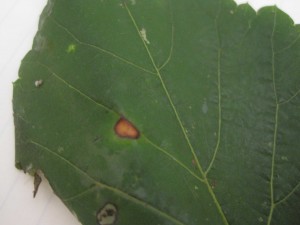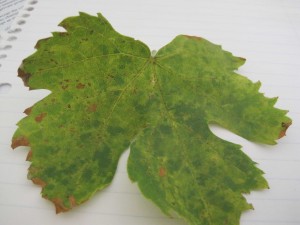Vineyard Diseases and How to Cure Them
It’s scary to think about how many predators are out there waiting to attack the average vineyard. Birds, bees, foxes, rabbits, deer – Even Bambi can’t be trusted! – and a host of insects, from the potato leafhopper to the Japanese Beetle, want nothing more than to devour the vines, from their leaves on down to the grapes themselves. And that isn’t counting the fungi.
Last weekend at Monticello, Gabriele Rausse taught a class on vineyard diseases that was as wonderful (Gabriele and Monticello) as it was depressing (birds, bees, deer – you get it). The predatory Bambis of the world can be controlled fairly easily with fences. Birds, which begin taking a serious look at the vines after the sugar level rises almost to the point where it is time to harvest, can be scared away with foil streamers that are hung at intervals so that they fly in the breeze.
But fungi are a different story. They require lots of attention, and no small amount of chemicals. Unlike California’s wine valleys, where vines grow in dry heat with cool nights and little rain, Virginia vineyards are subject to heat, humidity and lots of rain. (Especially this year.) All of which provides a good, but hopefully not perfect, environment for a variety of fungal diseases to take root, so to speak. Black Rot, Downy Mildew, Powdery Mildew, Botrytis (and not the good kind of Botrytis, the “noble rot” responsible for Sauternes) and many other diseases just lie in wait for the conditions that enable them to ruin a vineyard.
So, that means spraying. Not just once or twice, but routinely, weekly and especially after three-quarters of an inch or more of rain. We’d love to go organic and dispense with the spraying, but it’s not possible in Virginia, at least not with vines. I don’t know if other fruits and vegetables can be grown in Virginia without spraying, but I’m inclined to think you can’t. Certainly, Virginia Tech’s Cooperative Extension service web site has tons of information about spraying programs for fruit and vegetables, which implies that fungicides are needed. But whatever the case for other types of fruit, wine grapevines require spraying.
That’s also true in other environs. Gabriele said they had to spray in his native Italy (the Veneto region), for example. So, it’s not a crime to spray. But it does make for a lot of work and expense, one of the reasons, in fact, that Virginia wine is so expensive.
And by the way, if you're interested in this subject, the best source of information availale, at least for Virginia viticulturists — and probably for grape farmers everywhere — is Mizuho Nita's blog. It's a must-read for anyone interested in growing wine grapes in Virginia.
Spraying is a discipline, and it's one of those things you have to do when it's needed, whenever it's needed, with no exceptions. Hard work, for sure. But I think it's worth it, and that the end result of all that pest management will be wine that is truly memorable.
Category: All Posts, Resources, Viticulture




